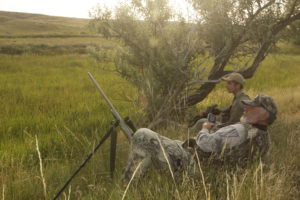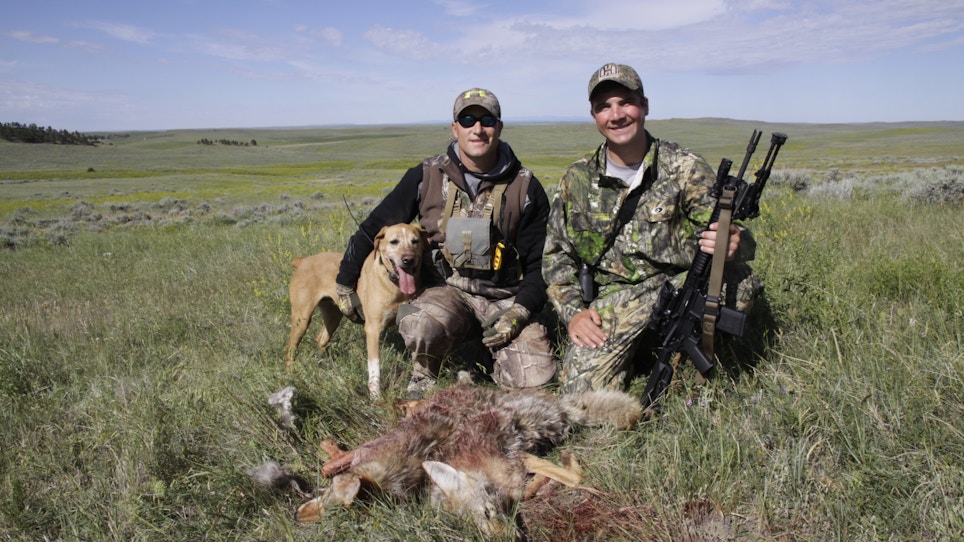Levi Johnson (left) and Cole Kayser with a couple of summer coyotes, a move that may help some fawns gains a foothold and survive until autumn. (Photo: Mark Kayser)
It’s the time of year when coyotes decide it’s time to dine at another diner. Forget roadkill, rodents and other survival rations coyotes scrounge up. There’s fawn on the menu and coyotes pull a “Rockford Files” Firebird reverse-J-turn to slide into some of the best eats of the season.
Wildlife agencies west and east have documented the dramatic shift of a coyote’s diet once they discover the first fawn of the season. Some research indicates that diet may transition to as high as 70 percent fawns once they begin hitting the ground. Coyotes aren’t species specific either. They’ll prey on whitetail, mule deer and pronghorn fawns with equal opportunity.
Other predator species also note the appearance of fawns on the landscape and take advantage of the new menu item. Depending on density,black bears also can have a significant impact on newborns fawns. You can Google more coyote predation research, but it’s an undisputed fact that coyotes and other predators, like black bears, focus on newborn fawns as a major food source in summer.
Unfortunately, black bears are considered a game species and thus managed with stricter regulations. Coyotes, on the other hand, receive little management, if any, in most states. This means for the most part, you can hunt them 365-days-a-year and in many cases, 24/7.

Focus on calls that mimic prey species in your area to get the attention of coyotes in summer. (Photo: Mark Kayser)
Therein lies the beef. Even though you can hunt them year-round; should you? Furtakers often shun warm-season hunting. There beef is obvious. Any coyote that makes it through the summer is just one more prime fur to take in the cold-weather months.
On the pro side of the debate, coyote enthusiasts revel in the fact you can vocalize and even use dogs to sucker summertime coyotes into range. Coyotes that were paranoid before the green up now boldly run right into rifle range. Hunting with sweat dripping down your forehead can be downright fun. These summer coyote chasers also point out that shooting coyotes now could save a fawn’s life. This is also true, but it comes with its own debate.
The first question to ask is whether coyotes are truly having an impacton your big game recruitment? That could be difficult at best to answer without professional help. Taking detailed notes of all fawns you discover or capture on trail camera, and then comparing those over a series of years could give you some answers. A local biologist could also shed some light on predation in the region. Maybe the coyote problem isn’t as bad as you believe? If you manage land maybe just more cover habitat could help hide those fawns?
Even so, most predator management specialists will explain, coyote or predator management needs to be intense just prior to fawning or undertaken on a year-round basis to have any impact. Coyotes quickly fill niche areas void of a coyote presence. This is particularly true of an area with a Garden-of-Eden makeup. Coyotes seek these areas out.
Those points noted, removing a coyote or even multiple coyotes from an area before or during the fawn season can’t hurt. It’s like a zit on your cheek. You can leave it and it will likely get worse before it gets better. Or you can medicate and cleanse the area. It won’t guarantee that a zit won’t return, but it will help for a period of time.
The same is true of hunting coyotes in the warm-weather season. Any coyote you remove now is one less coyote that could kill a fawn. Remove several and you’ve made a dent, albeit brief, but it could just create a window for a fawn to strengthen up and lead to its survival. I say pop the cork if you feel like it! What say you?






